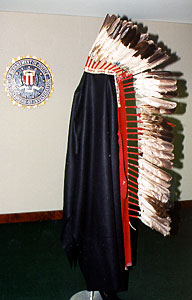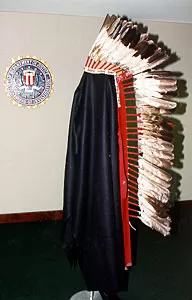Geronimo was a famous Apache Indian who was known as a great medicine man and spiritual leader. For years, the Apaches, like many Native Americans, fought U.S. troops for the right to remain on their lands.
In 1874, Geronimo and his band were captured and forcibly moved to a reservation in San Carlos, Arizona. He escaped soon after and, for the next several years, lived a life on the run. In 1886, he was captured again and sent to Florida for imprisonment with the understanding that he would eventually be permitted to return to his native Arizona.
The promise was not kept, however, and in 1894, he and a small band of men, women, and children were relocated to Fort Sill, Oklahoma.
It was while he was a prisoner of war in Fort Sill that Geronimo was given permission from the War Department to attend a ceremonial farewell of surviving Native American chiefs, called “The Last Pow-Wow.”
The event took place in Collinsville, Indian Territory, (shortly before it became the state of Oklahoma) from October 14-19, 1907. As a condition of his travel, he was assigned an escort named Jack Moore, a man who would become a good friend of Geronimo.


During the five-day summit, Geronimo wore an eagle-feathered war bonnet that had been given to him by the Comanche.
After performing in a dance, Geronimo gave his costume, moccasins, and headdress to Moore in appreciation for his loyalty and friendship.
Years later, Moore presented the headdress and costume to the C.W. Deming family of Oklahoma, as a thank you for their generosity to the Native American population of Oklahoma.
Nearly a century later, the Federal Bureau of Investigation found itself investigating the sale of this headdress that was once passed from family to family, and was now being sold illegally over the Internet.
On September 3, 1999, the FBI received an email complaint from an alert observer, stating that the Geronimo eagle-feather headdress was being sold on the Internet.
The headdress worn by Geronimo so many years ago at the ceremonial farewell was for sale for one million dollars.
The seller requested that only serious international inquiries be sent, which indicated that he was aware that it was illegal to sell eagle feathers in the United States.
The sale of eagle feathers, including those of the golden eagle, is prohibited in the United States pursuant to the Bald Eagle Protection Act, the Migratory Bird Protection Act, and the Lacey Act.
On September 7, 1999, an FBI Agent working undercover sent an e-mail message to the seller, expressing interest in the war bonnet.
A man acting as the broker of the war bonnet telephoned the undercover agent on September 8, 1999, to tell him that the war bonnet was still available, but that the selling price had risen to $1.2 million, due to the increased number of interested parties.
The agent asked him to send him pictures of the war bonnet, as well as any information authenticating the headdress. The broker reiterated that the eagle feathers were illegal to sell in the United States.
Two days later, the agent received a package containing pictures of the war bonnet. The package also contained numerous letters from the C.W. Deming family explaining the history of the acquisition of the war bonnet. A copy of the law 16 USC 668, The Bald Eagle Protection Act, prohibiting the sale of the war bonnet, was attached.
The agent e-mailed the photographs of the war bonnet to a United States Fish and Wildlife Service (USFWS) agent who positively identified the feathers in the photograph as eagle.
Between September 10 and September 23, 1999, the undercover FBI Agent engaged in numerous telephone conversations with the broker discussing the provenance of the war bonnet.
During these discussions, the broker stated that the current owner of the headdress was Leighton Deming, an attorney and grandson of the late C.W. Deming.
On September 23, 1999, the seller mailed a second package to the agent which contained two other letters and a short story. One of the letters was from Leighton Deming describing how he acquired the war bonnet from his grandmother.
After numerous phone conversations, it was finally decided that the broker and Deming would sell the war bonnet to the agent for $1.2 million. The broker would receive $500,000 for his part of the headdress sale, and Deming would receive $700,000.
On October 12, 1999, the broker and Deming met with a FBI undercover agent and an undercover agent from USFWS. They discussed the sale of the war bonnet with the agents and made the sale of the headdress for $1 million. At this point both men were placed under arrest.
In February 2000, Deming pleaded guilty to violation of the Bald Eagle Protection Act.
The United States Fish and Wildlife Service Agent examined the war bonnet and determined that it was composed of golden eagle feathers.
The sale of the war bonnet violated the Bald Eagle Protection Act, the Migratory Bird Protection Act, and the Lacey Act. These statutes were enacted to ensure the survival of the American Eagle as the USA’s national symbol.
Further Reading on Geronimo, via Amazon
Geronimo – An American Legend (1993) Jason Patric, Gene Hackman
Geronimo: His Own Story by Geronimo
Once They Moved Like the Wind: Cochise, Geronimo, and the Apache Wars by David Roberts
Wild Justice: The People of Geronimo Vs. the United States by Michael Lieder, Jake Page
Geronimo: The Man, His Time, His Place by Angie Debo
The Geronimo Campaign by Odie Faulk
Rifles, Blankets, and Beads: Identity, History, and the Northern Athapaskan Potlatch by William Simeone
Chiefs & Chief Traders: Indian Relations at Fort Nez Perces, 1818-1855 by Theodore Stern
White Man’s Wicked Water: The Alcohol Trade and Prohibition in Indian Country, 1802-1892 by William Unrau
Indian Trade Goods by Arthur Woodward
The Four Winds Guide to Indian Trade Goods & Replicas:
Including Stone Relics, Beads, Photographs, Indian Wars, and Frontier Goods by Preston Miller
Field Guide to Flint Arrowheads & Knives of the North American Indian: Identification & Values by Lawrence Tully, et al
As an Amazon Associate, I earn from qualifying purchases.
Related Stories
Five Eyes Law Enforcement Group speech by AFP Commissioner, Reece Kershaw
FBI Top Ten Art Crimes, FBI Art Crimes Team – Updated
INTERPOL’s global database of Stolen Works of Art





